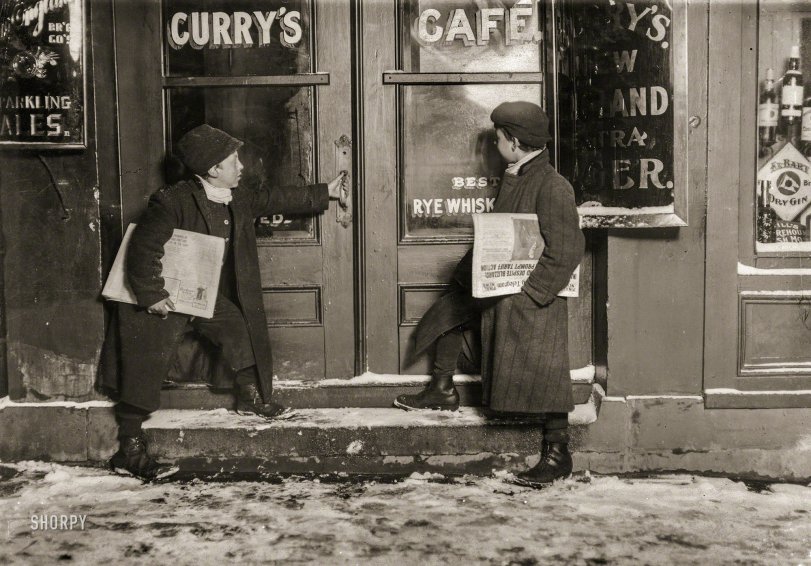


Framed or unframed, desk size to sofa size, printed by us in Arizona and Alabama since 2007. Explore now.
Shorpy is funded by you. Patreon contributors get an ad-free experience.
Learn more.

- Baldwin 62303
- Baldwin VO-1000
- Cold
- No expense spared
- Tough Guys
- Lost in Toyland
- And without gloves
- If I were a blindfolded time traveler
- Smoke Consumer Also Cooks
- Oh that stove!
- Possibly still there?
- What?!?
- $100 Reward
- Freeze Frame
- Texas Flyer wanted
- Just a Year Too Soon
- WWII -- Replacing men with women at the railroad crossing.
- Yes, Icing
- You kids drive me nuts!
- NOT An Easy Job
- I wonder
- Just add window boxes
- Icing Platform?
- Indiana Harbor Belt abides
- Freezing haze
- Corrections (for those who care)
- C&NW at Nelson
- Fallen Flags
- A dangerous job made worse
- Water Stop
Print Emporium
A Double Shot: 1909

March 1909. Hartford, Connecticut. "9:30 P.M. A common case of 'team work.' Smaller boy (Joseph Bishop) goes into saloon and sells his last papers. Then comes out and his brother gives him more. Joseph said, 'Drunks are me best customers. I sell more'n me brudder does. Dey buy me out so I kin go home.' He sells every afternoon and night. Extra late Saturday. At it again at 6 A.M. Sunday." Photo by Lewis Wickes Hine for the National Child Labor Committee. View full size.
Tricks of the trade
Being a newpaper boy does teach you the be resourceful. When I was 14 or so I had a paper route delivering the York Dispatch in South York, Pa. One of the streets I delivered on marked the edge of the city, and was the main east-west corridor to the affluent neighborhoods, as well as the access to the York Hospital. I always used to do that street last because not infrequently someone driving by would see me with my papers and try to buy one. I always said I couldn't sell for the face price (I think it was a nickel), and I generally got ten cents, and occasionally a quarter. Of course at the end of my route I was a paper or two short, so I would go down to the pharmacy and buy the necessary papers at five cents each, making a clear profit of five cents. An extra 10 or 15 cents was gold in those days.
The Bishop Boys
This is Joe Manning, of the Lewis Hine Project. I tracked down the story of these boys seven years ago. I interviewed the niece of Joseph Bishop, the boy on the left. See it here.
https://morningsonmaplestreet.com/2015/01/01/joseph-meyer-bishop/
184 State Street
According to historian Joe Manning:
"Curry’s Café was owned by John J. Curry, 34 at the time of the photograph, and married with no children. He was born in Ireland and entered the US through Ellis Island in 1901. The café (called a saloon in the directory) was located in downtown Hartford at 184 State Street, an area which was totally redeveloped in the 1960s to accommodate Constitution Plaza, a large office and retail center."
More on the Bishop boys
The 1910 census revealed that Joseph’s unnamed brother in the picture was Meyer (some records spell it Myer). According to the census and the Hartford city directories, Curry’s Café was owned by John J. Curry, 34 at the time of the photograph, and married with no children.
























On Shorpy:
Today’s Top 5